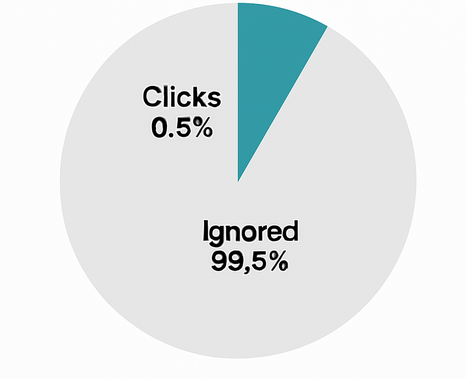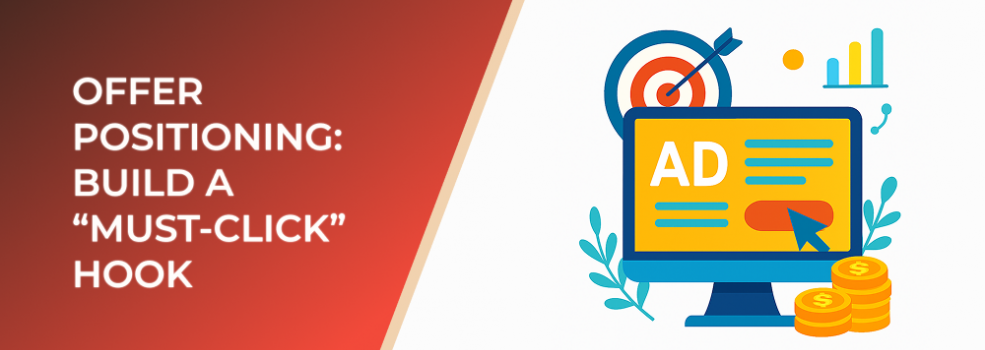Your offer determines more than your conversion rate. It shapes the initial click itself. A strong offer with a clear hook can lift CTR, reduce acquisition costs, and pre-frame users to convert long before they see your landing page. In a digital environment where the average person is exposed to over 6,000 ads per day, your offer needs more than a good message. It needs a compelling, fast-to-grasp hook.
Below is a framework for building an offer positioned to stop the scroll and maximize clicks.
Why Offer Positioning Matters
Research shows that 80 percent of users decide whether to click in under two seconds. That means complex explanations fail, and vague claims disappear in the feed. Ads with a single clear value proposition can increase clicks by up to 45 percent compared to ads with multiple competing messages.

Average daily ad exposure per person: 6,000–10,000 ads
Your hook is the core idea the user understands instantly. When the hook is strong, everything becomes easier: CPMs improve, CTR rises, and your landing pages convert better because visitors arrive with the right expectations.
Step 1: Define the Primary Value, Not Features
Most ads fail because they present features, not value. Users click when they understand what they gain.
Ask yourself:
-
What is the fastest, clearest benefit someone gets?
-
What problem does this remove immediately?
-
Why should they care right now?
Ads focusing on outcome-based messaging see up to 32 percent higher CTR compared to feature‑based ones.
Step 2: Shape the Hook Around a Strong Contrast
People respond to contrasts: before vs after, with vs without, slow vs fast. Strong contrast increases clarity and emotional impact.
Examples of contrast-driven hooks:
-
From 7-day wait to instant delivery
-
From guessing to verified data
-
From manual work to automated results
Visual and verbal contrast can increase attention by around 40 percent, according to eye‑tracking tests.
Step 3: Add a Specific, Quantifiable Element
Numbers stop the scroll. They make promises feel more real.
Use:
-
Time savings
-
Cost reductions
-
Percent improvements
-
Volume (templates, assets, steps)
Ads with numeric claims generate up to 2x higher engagement than general statements.
Step 4: Reduce Perceived Risk
People click faster when the offer feels safe.

Typical click-through rate (CTR) for display ads is approximately 0.5% or lower
Examples include:
-
Free trials
-
No credit card required
-
Cancel anytime
-
30-day guarantee
Reducing friction points can lift conversion rates by 20 to 50 percent and increases initial click‑through rates because users feel the barrier to entry is low.
Step 5: Express the Hook in One Line
Your final hook should fit in a short, high‑clarity line:
-
One sentence
-
One benefit
-
One angle
This line forms the basis of your ad headline, opening line, and top creative text.
A one‑line hook can improve comprehension by more than 50 percent, significantly boosting scroll‑stopping power.
Examples of High‑Performance Hook Types
1. Speed Hooks
Promises based on immediate results.
-
"Launch campaigns in minutes"
-
"Get insights instantly"
Speed-based messages can drive up to 30 percent higher CTR.
2. Simplicity Hooks
Reducing complexity.
-
"Everything you need in one dashboard"
-
"No setup, no tech skills"
Simplicity framing increases engagement by around 25 percent.
3. Transformation Hooks
Clear before‑after shift.
-
"Turn browsing into buying"
-
"Make targeting precise again"
Transformation‑focused offers often outperform generic claims by 20 to 40 percent.
Step 6: Align Your Hook With Your Creative Format
The best hook will fail if the visual doesn't support it. Users take in visuals 60,000 times faster than text, so the first impression happens before they read anything.
Use visuals that reinforce the core value:
-
If the hook is about speed: clean, minimalist graphics
-
If the hook is about clarity: charts or comparisons
-
If the hook is about simplicity: large whitespace and bold icons
When text and visuals communicate the same benefit, ads see up to 48 percent higher response rates.
Step 7: Keep Iterating and Testing
The highest‑performing offer hooks usually come from systematic testing, not guesswork. Running 3 to 5 variants of the same offer with different angles can reduce CAC by up to 35 percent.
Focus on testing:
-
Different benefit angles
-
Different numbers or proof points
-
Different contrast frames (before/after, manual/automated, slow/fast)
Iterating weekly builds compounding efficiency in both clicks and conversions.
Final Thoughts
A “must-click” hook is not created by writing more clever lines. It comes from sharp, simple positioning. When your offer shows immediate value, feels low‑risk, and delivers a clear contrast, people click without hesitation.
Strong offer positioning is one of the highest-leverage improvements you can make to your advertising performance.

